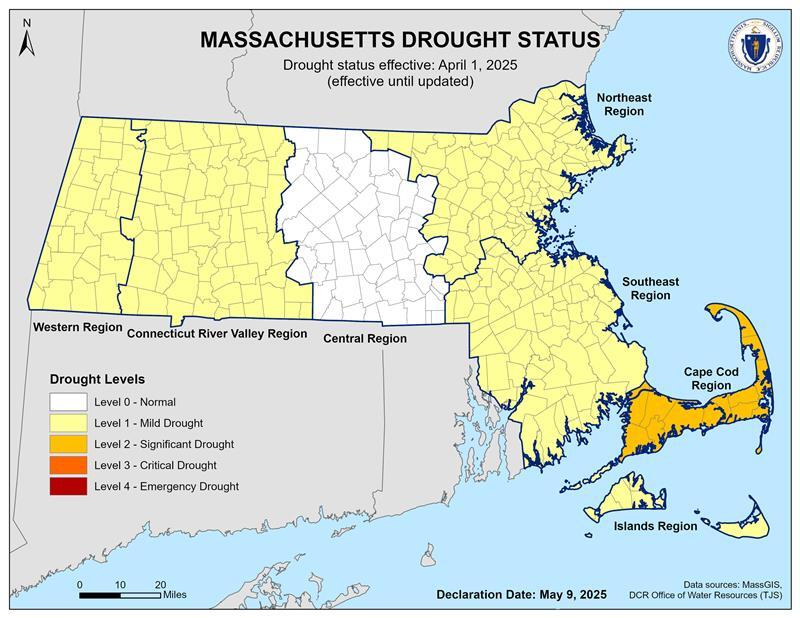Press Release: 5/9/2025
Drought Conditions Improve as Central Region Returns to Normal
FOR IMMEDIATE RELEASE:
5/09/2025
MEDIA CONTACT
Aisha Revolus, Communications Manager
Online
Email Aisha Revolus, Communications Manager at aisha.revolus@mass.gov

BOSTON — Today, Energy and Environmental Affairs (EEA) Secretary Rebecca Tepper declared the Central Region will be downgraded from a Level 1-Mild Drought to Level 0-Normal Conditions. The Northeast and Islands Regions were also lowered to a Level 1 – Mild Drought, joining the Connecticut River Valley, Southeast, and Western Regions. The Cape Cod Region remains at a Level 2 – Significant Drought.
Recent rains have provided much-needed relief from the ongoing drought conditions. While this is a positive step, we still need more rainfall to fully restore our water systems and ensure that groundwater levels rise effectively. As outlined in the Massachusetts Drought Management Plan, a Level 1 – Mild Drought and a Level – 2 Significant Drought require detailed monitoring of drought conditions. These levels also require ongoing coordination among state and federal agencies to implement drought response actions such as water use restrictions. Additionally, engagement with municipalities, including local Boards of Health, is essential. This includes providing technical outreach and assistance to water suppliers and affected municipalities.
“After several months of experiencing drought conditions, I am pleased to share that the Central region has returned to normal,” said EEA Secretary Rebecca Tepper. “The rain we have received in recent months has helped replenish our streams and groundwater levels and nourished our gardens and forests. However, with the growing season underway and several regions still facing long term dry conditions, let’s continue to do our part to by following local water restrictions.”
Above-average precipitation over the last couple of months has helped improve streamflow, lakes/impoundments and fire danger indices in several regions. However, drought conditions and in particular groundwater levels are still affecting the regions due to ongoing long-term precipitation deficits. In most regions of the state, monthly precipitation has generally ranged from around 4 to 6 inches. Over the past three months, the Cape and Islands regions have experienced 20-40 percent below average precipitation. The data collected by the Drought Management Task Force (DMTF) reflects the observations made from the start of the drying conditions in August 2024 through the end of April 2025. Residents can report dry environmental conditions they are experiencing and submit photos to support state drought monitoring efforts here.
The Massachusetts Department of Environmental Protection (MassDEP) will continue to provide technical assistance to communities on managing their water systems, including assistance on the use of emergency connections and water supplies.
It is important to note that the Massachusetts Water Resources Authority (MWRA) water supply system is not experiencing drought conditions, as defined within its individual plan. However, private well users and other sources of water within the same river basins are impacted by drought conditions. All sources of water, regardless of their location or type of withdrawal, ultimately draw from the same river basin. It is important for all users to do their part to conserve water.
Below are recommendations for communities and individuals living and working within a Level 1 – Mild Drought and Level 2 – Significant Drought including those utilizing a private well. Residents and businesses are also asked to check with their local water system in case more stringent watering restrictions are in place.
For Regions in Level 1 – Mild Drought
Residents and Businesses:
- Minimize overall water use;
- Limit outdoor watering to one day per week from 5:00 PM to 9:00 AM, or less frequently if required by your water supplier;
- Plant only local and drought-resistant species;
- Fix indoor leaks, such as from toilets, faucets, and showers, which result in more than 60 percent of indoor use;
- For larger buildings and businesses, conduct water audits to identify areas of leaks and potential water conservation opportunities;
- Minimize lawn sizes; and,
- Harvest rainwater for outdoor watering.
Communities/Municipalities:
- Establish a year-round water conservation program that includes public education and communication, taking advantage of the state’s library of outreach materials;
- Provide timely drought and water conservation information to residents and businesses;
- Check emergency inter-connections for water supply; and
- Develop a local drought management plan (learn more here).
For Regions in Level 2 – Significant Drought
Residents and Businesses:
- Minimize overall water use and be particularly mindful of indoor water use.
- Follow local water use restrictions
- Fix indoor leaks, such as from toilets, faucets, and showers, which result in more than 60 percent of indoor use;
- For larger buildings and businesses, conduct water audits to identify areas of leaks and potential water conservation opportunities.
Immediate Steps for Communities/Municipalities:
- Limit or prohibit washing of hard surfaces (sidewalks, patios, driveways, siding); personal vehicle or boat washing.
- Establish water-use reduction targets for all water users, identify top water users and conduct targeted outreach to help curb their use.
Short- and Medium-Term Steps for Communities/Municipalities:
- Establish a year-round water conservation program that includes public education and communication, taking advantage of the state’s library of outreach materials.
- Provide timely information to local residents and businesses.
- Implement or establish drought surcharge or seasonal water rates.
- Check emergency inter-connections for water supply.
- Develop or refine your local drought management plan using guidance outlined in the state Drought Management Plan.
State agencies will continue to closely monitor and assess conditions across the state, coordinate any needed dissemination of information to the public, and help federal, state, and local agencies prepare additional responses that may be needed in the future. The Drought Management Task Force will meet again on Monday, June 9 at 1:00 pm. For further information on water conservation and what residents can do, visit the EEA’s drought and water conservation pages.